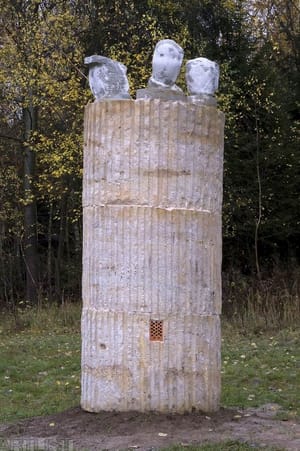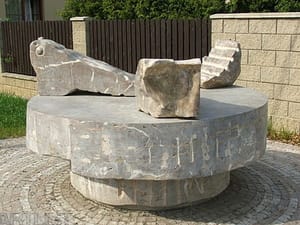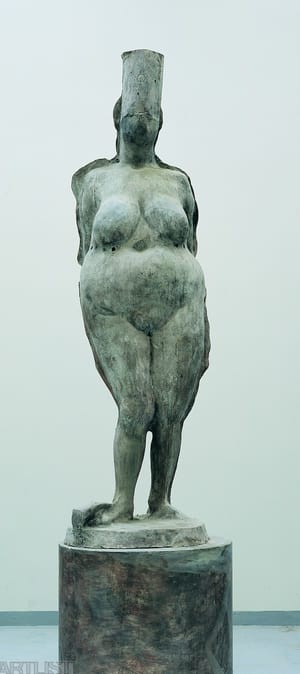- First Name
- Jan
- Surname
- Hendrych
- Born
- 1936
- Birth place
- Prague
- Place of work
- Prague
- CSU Library
- ↳ Find in the catalogue
About artist
Jan Hendrych was the son of lawyer Jaroslav Hendrych and sculptor Olga Hendrychová (Tobolková), who was lucky enough to be the student of prominent Czech sculptor Otakar Španiel. This is how Hendrych certainly must have acquired his first important information and then went on to successfully pursue his studies in sculpture. During 1955 – 1961 he studied at the Academy of Applied Arts, Architecture and Design in Prague in the Studio of Sculpture of Josef Wagner and Jan Kavan, following which he completed his post gradual studies at the Academy of Fine Arts in Prague under Karel Hladík and Karel Lidický. Similarly to many other students, Jan Hendrych was also searching for his own creative opinion in the convoluted situation formed by the climate of the propagandistically focused dictate of the communist ideology of the 1950s. A number of artists from this time period tried to follow up on the ruptured continuity and find cleansing outcomes by picking up where the interwar avant-garde had left off.
In the beginning while still studying, Hendrych pursued the art of portrait. But he was soon captivated by the figure as a whole and examined possibilities of depicting the figure in a less classical way. There were several incentives: Hendrych was interested in the expressive conception of material, similarly to how Czech Baroque Style had done, for example. The work of his international pier Marin Marini also related to expressionism; he was introduced to him by Prof. Kaplický who was teaching at the Academy of Applied Arts, Architecture and Design. A perpetual topic for students back then was also Otto Gutfreund and his Cubistic sculpture modelling. And finally, very popular was the work of the English sculptor Henry Moore whose statues stood out with their smooth material form and although figural, they bordered between realistic and abstract style. Hendrych did not find a model for literal copying in neither of the styles, rather it was the combination of both and the experience with both that provided him with important lessons, which projected into his later work and helped to form Hendrych’s personal style.
At the beginning of the 1960s, Hendrych briefly pursued structural abstraction, but he did not find creative fulfilment in this direction either. He found his path during the 1960s when sculptures started to emerge pointing in a new direction, which was defined at the end of the 1960s as “new figuration”. Hendrych also started to experiment with new materials – for example with plastic (Figura s rastrem (Figure with a Grid), polyester, 1960). In some of his figures he combined plaster with plastic, sometimes even with industrial elements and occasionally he partially polychromed the statue. His subjects are civil topics such as a man sitting on a chair reading a newspaper. It is not a mare image of a person, but rather a symbol of everyday human mythology. Hendrych’s period of new figuration is an echo of George Segal’s sculptures who also portrayed people in typical urban situations such as women sitting on a chair, men relaxing on a bench, a bus driver, or a figure behind a bar table. Some elements were real objects such as a chair, a table, a bed or a window incorporated into the whole artistic object. The notion new figuration had not been exactly defined yet. It practically included all possible expressions that revived interest in the figure and which appeared to be a current testimony. Morphologically it includes an entire range of types and the semantic tone is also broad: from grotesque, through existential urgency, all the way to civil sobriety. New figuration primarily represented the return to the human figure as the foundation for art work. And that was perfectly suitable for Jan Hendrych who was an essential figural artist.
The first time Hendrych exhibited his sculpting work in public was in 1964 in Liberec in the open air exhibition Socha (Sculpture) 1064, which introduced a wider display of contemporary sculpture in Czechoslovakia for the first time. This exhibition, however, was overtaken by the subsequent exhibition organized in the streets of Liberec in 1969. It introduced already mature expressions of Czech sculpture including work by Jan Hendrych. Here he installed a plaster sculpture of two male figures. One was sitting on a chair with a jacket casually thrown over his shoulders and with his hands in his lap and the other was standing with his jacket casually unbuttoned. It looked like an informal situation – civil scene from any everyday environment around us.
Hendrych reacted to the occupation in 1968 by creating several busts of state secretaries (Tajemník velký (Large State Secretary), 1968-69). He was not allowed to exhibit after 1969 so he made a living as a restorer of statues. He was able to exhibit his own work until 1988 in the City Gallery Prague. During the time that he was “excluded from life” Henrych continued to return to a more classical sculpting form increasingly often: his figural compositions lacked that civilization flavour. He created primarily female figures and especially nudes in which Hendrych continued in the tradition of pre-war modernism, but also utilized experiences from Czech Baroque sculpture. The names of his sculptures such as the series of sculptures titled Pomona or Studie aktu (Study of the Nude) also reveal his respect for modernistic classics as well as his admiration of timeless topics from the time of antiquity. However, Hendrych is not trying to be a worshiper of female beauty as it was in the world of antiquity or renaissance. His Pomona has a bulging stomach and a rather non-elegant posture. It resembles more our Venus of Dolní Věstonice than the Greek Aphrodite. Some of his other statues are inspired by Chinese art, for example his statue of a man titled Vzpomínka na Čínu (Memory of China). Hendrych’s approach to material is also not very classical. He often leaves certain spots as if unprocessed, some figures have an obvious surface structure – for example an imprint of wool tape (Kalhoty (Pants), 1978-1991) or the surface is “sloppily” worked with an expressive gesture. Occasionally, Hendrych manages to sneak a grotesque accent in some of his statues (Dívka s koulí (Girl with One Ball)) and he also achieves certain lightness by using details of “low” culture (statue Piercing).
Jan Hendrych has always remained an essential sculptor, summarizing his admiration of the tradition of modernism, as well as all sculpture long before then. He also absorbed elements of art from the 1950s and 1960s, especially pop art and new figuration. In several of his sculptures he also explored the field of abstract non-figural art (sculpture Kolotoč (Carousel) , 2…). He was able to distinctively interpret all sources and create from various impulses solid and convincing creative style, managed with excellent sculpting craftsmanship.
- Author of the annotation
- Ivona Raimanová
- Published
- 2015
CV
1997 and 1999
he led two semesters of figurative modeling at the Academy of Fine Arts in Helsinki
1993 - 1995
vice-rector of the Academy of Fine Arts in Prague
1991 - 2009
professor, Academy of Arts in Banska Bystrica (sculpture studio)
Since 1990
professor, Academy of Fine Arts in Prague (studio of figural sculpture and medals)
1964 - 1967
Academy of Fine Arts in Prague (Karel Hladik, Karel Lidický)
1955 - 1961
college of Applied Arts in Prague (Jan Kavan and Josef Wagner)
1951 - 1955
Technical School of Interior Design, Prague, Václav Markup
Prices
1996 Ministry of Culture of the Italian Republic, the Biennale Dantesca, Ravennna
1992 Gold and bronze medals, Ravenna
1990 First Prize, Triennale sculpture, Sopot
Symposiums
2009, 2010, 2012
Smaltart, Vítkovice
1999
Symposium Guilin, China
1998
International Sculpture Workshop, Ruzomberok
Sculpture summer Jirčany
1994
International Symposium Jug, Hředle
1992
International Sculpture Symposium Hořice
1969
Artchemo, Pardubice
The symposium sculptures in metal, VCHZŽ Košice
1965
Symposium spatial forms, Elblag
1963
Europahaus, Vienna
- Member of art groups included in ARTLIST.
Exhibitions
- Solo exhibitions
-
2012
Jan Hendrych, Oblastní galerie Vysočiny v Jihlavě
2011/12
Jan Hendrych: Pekelných 75, Galerie Litera, Praha
2009
Jan Hendrych, Galerie Benedikta Rejta, Louny
2005
Jan Hendrych: Sochy, kresby, grafika, Wortnerův dům Alšovy jihočeské galerie, České Budějovice
Jan Hendrych: Sochy, kresby, grafika, Oblastní galerie Vysočiny v Jihlavě
Jan Hendrych: Sochy, kresby, grafika, České muzeum výtvarných umění, Praha
2002
Jan Hendrych: Plastiky a kresby, Galerie Magna, Ostrava
2001/2
Jan Hendrych: Šedesátá léta, Galerie Ztichlá klika, Praha
2001
Jan Hendrych, Galerie Ztichlá klika, Praha
1999
Jan Hendrych: Plastiky, Výstavní síň Synagoga, Hranice
Jan Hendrych: Plastiky, Galerie Nový Svět, Praha
1988
Jan Hendrych: Plastiky, Staroměstská radnice, Křížová chodba, Praha
1967
Jan Hendrych: Plastiky, Galerie umění, Ostrov (Karlovy Vary)
1966
Jan Hendrych, Galerie mladých, Mánes, Praha
- Group exhibitions not included in ARTLIST.
-
2014
Česká plastika (symbióza), Galerie Moderna, Praha
2013
Od informelu k figuře, Galerie Slováckého muzea, Uherské Hradiště
S Václavem Havlem, Galerie Ars 21, Český Krumlov
Hlava a portrét, Galerie Salva Guarda, Litoměřice
Pokrevní vztahy, Galerie Středočeského kraje (GASK), Kutná Hora
2012
Nad povrchem, Akademie věd České republiky, Praha
XX. letní keramická plastika / Summer Exhibition of Ceramic Sculpture, Hrad Klenová, (Klatovy)
Euroart 2012 Sdružení sochařů, Čech, Moravy a Slezska, Zámek Klášterec nad Ohří
Socha a barva, ČVUT - fakulta architektury, Praha
2011
19. Letní keramická plastika / Summer Exhibition of Ceramic Sculpture, Hrad Klenová,(Klatovy)
2010
Jan Hendrych a Richard Konvička: Maso a kost / dvě podoby figurace, Severočeská galerie výtvarného umění v Litoměřicích, Litoměřice
Smalt Art. Krajina, tělo, záření, Nostický palác, Praha
2009
Figurama 09, Univerzita Tomáše Bati ve Zlíně, Zlín
Figurama 09, Centrum Kultury Zamek, Poznaň
Figurama 09, Zlatý dům evropské kultury, České Budějovice
Figurama 09, Berlaymont building, Brussel
Figurama 09, Staroměstská radnice, Praha
Socha a město Liberec 1969. Výstava o výstavě Liberec 2009, Oblastní galerie v Liberci
Věčná pomíjivost, Kostel Zvěstování Panny Marie, Litoměřice
2008
Zrozeno do prostoru, Hrad Sovinec, Sovinec
2007
České umění XX. století: 1970-2007, Alšova jihočeská galerie v Hluboké nad Vltavou
Rande 52, Galerie Deset, Praha
2006
Cesta mramoru, II. ročník soch. sympozia v Dobřichovicích, Chodovská tvrz, Praha
2005
Pražské ateliery, Galerie U Prstenu, Novoměstská radnice, Praha
Parafráze, Severočeská galerie výtvarného umění, Litoměřice
Opojná plasticita a ztělesnění duchovního světa, Figura v českém soch. 20. století, Mánes, Praha
2004
Mezinárodní výstava k rozšíření Evropské unie, Dublin, Irsko
2003
Výstava pedagogů AVU v Praze, Břežice, Slovinsko
Umělecká beseda 1863 2003, Městská knihovna, Galerie hl.m.Prahy, Praha
Minisalon, Jazzová sekce Artforum, České centrum, Paříž, Francie
2002
Výstava pedagogů AVU, Břežice, Slovinsko
Sochařské portréty O. Špačka, Galerie Špaček, Lysolaje, Praha
Sdružení Hapestetika, Atény, Řecko
Profesoři a docenti Akademie výtvarných umění, Zámecká galerie, Karviná
Galerie Chagall, Ostrava
Galerie FEM (spolu s A. Sládkem)
2001
Barevná socha, Severočeská galerie výtvarného umění, Litoměřice
2000
Umělecká beseda 1999/2000, Mánes, Praha
1999
Umění zrychleného času, České muzeum výtvarného umění, Praha
1998
Záznam o Ikarově letu, Muzeum umění, Olomouc
6. členská výstava Umělecké besedy, Mánes, Praha
10 sochařů Umělecké besedy, zámek, Hranice
1997
Umělecká beseda 1997, Mánes, Praha
1996
Umělecká beseda 1996, Mánes, Praha
Bienále Dantesca, Ravenna, Itálie
1995
3. výstava VO Umělecké besedy, Mánes, Praha
1994 - 1995
Artchemo 1968/1969, Zlín
Artchemo 1968/1969, Pardubice
Artchemo 1968/1969, Bratislava, Slovensko
1992
Ohniska znovuzrození, České umění 1956 - 1963, Galerie hlavního města Prahy
Nová figurace, Východočeská galerie, Pardubice
Nová figurace, Severočeská galerie výtvarného umění v Litoměřicích, Litoměřice
Bienále Dantesca, Ravenna, Itálie
1992 - 1998 členské výstavy výtvarného odboru Umělecké besedy, Mánes, Praha
1991
Šedá cihla 78/1991, Galerie U bílého jednorožce, Klatovy
1990
Salon, kresba a grafika, Tokio, Japonsko
1989
Úsměv, vtip a škleb, Art Centrum, Palác kultury, Praha
Trienále plastiky, Sopoty, Polsko
1988
Salon pražských výtvarných umělců 88, PKO Praha
Forum 88, Holešovická tržnice, Praha
České a slovenské sochařství 1948-1988, Varšava
1987
Obrazy a sochy pražských členů SČVU k znovuotevření budovy Mánesa, Praha
Galerie M. A. Bazovského, Trenčín
1985
Výtvarní umělci k 40. výročí osvobození Československa, Praha
Galerie M. A. Bazovského, Trenčín
1983
výběr SČVU, Helsinky, Finsko
Galerie M. A. Bazovského, Trenčín
Dvacet let Galerie hl. města Prahy, Praha
1980
Výtvarní umělci k 35. výročí osvobození Československa, Praha
1977
14. bienále moderní plastiky, Middelheim Antverpy, Belgie
1975
Socha piešťanských parkov, Piešťany
doplnění výstavy Čs. Knihy, drobná plastika, Londýn
1972
České moderní sochařství, Bologna, Itálie
1970
Prager Künstler, Haus am Kleistpark, Berlín
1969
Věcné dialogy, Okresní muzeum, Písek
Socha a město, Liberec
1967
Výstava mladých 67, výstavní síň ÚLUV, Praha
Nové cesty, Gottwaldov, nyní Zlín
II. sochařské bienále, Oblastní galerie, Olomouc
1966
Výstava mladých, Dům umění, Brno
Jarní výstava 1966, Mánes, Praha
1965
Výstava mladých, výstavní síň ÚLUV, Praha
1964
Socha 64, Liberec
Rychnov 64, Rychnov nad Kněžnou
Jazz ve výtvarném umění, Divadlo hudby, Praha
1961
I. pražský festival mladé grafiky, Uměleckoprůmyslové muzeum, Praha
- Collections
- Národní galerie, Praha; Galerie hlavního města Prahy; Galerie středočeského kraje, Kutná Hora; Východočeská galerie, Pardubice; Galerie moderního umění, Hradec Králové; Orlická galerie, Rychnov nad Kněžnou; Galerie výtvarného umění, Jičín; Galerie moderního umění, Roudnice nad Labem; Severočeská galerie výtvarného umění, Litoměřice; Galerie Benedikta Rejta, Louny; Galerie výtvarného umění, Cheb; Galerie Klatovy/Klenová; Okresní vlastivědné muzeum, Jindřichův Hradec; Horácká galerie výtvarného umění, Nové Město na Moravě; Krajská galerie výtvarného umění, Zlín; Muzeum umění, Olomouc; Galerie Zlatá husa, Praha; Východoslovenská galéria, Košice; Sbírka pařížské mincovny, Paříž
- Other realisations
2008 Křížová cesta (socha Vykoupení), pískovec, Dvůr Králové 2005 pamětní deska B. Suttnerové, bronz, Palác Kinských, Praha 2003 pomník J. Krčína z Jelčan, bronz, mramor, Třeboň 1999 pamětní deska F. Kafkovi, bronz, palác Kinských, Praha busta Václava Hollara, bronz, Soukenická, Praha 1997 pamětní deska UNESCO, bronz, Staroměstská radnice, Praha 1996 Most, granit, sympozium Guilin, Čína 1995 pamětní deska, Pražského povstání, Staroměstská radnice 1992 Nachýlená figura, granit, Manchester by Sea, USA 1986-1987 Labe, pískovec, Přední Labská (Špindlerův Mlýn) Plastika s rostlinnými motivy, sídliště Lhotka, Praha 1985 Kašna, pískovec, Jižní město, Praha 1984 Plastika s rostlinnými motivy, sídliště Lhotka, Praha 1976 Býk, pískovec, SOU Písnice 5 reliéfů, bronz, Mramorový palác, Teherán 1973 keramická stěna, Čedok Berlín 1971 centrální plastika, pískovec, hřbitov Stachy 1969 Velká hlava, železo, Košice 1965 Nachýlená figura, železo, Elblag
Monography
- Monography
Václav Erben, Jan Hendrych, Galerie Benedikta Rejta, Louny 2009. Jna Kříž, Jan Hendrych, České muzeum výtvarných umění, Praha 2005. Richard Drury, Jan Hendrych, Galerie Magna, Ostrava 2002. Václav Erben, Jan Hendrych, Galerie Ztichlá klika, Praha 2001. Josef Kroutvor, Jan Hendrych: Mosty a brány, Galerie Ztichlá klika, Praha 1997. Marie Halířová, Jan Hendrych: Plastiky, Galerie hlavního města Prahy 1988. Jiří Šetlík, Plastiky Jana Hendrycha, Ostrov (Karlovy Vary) 1967.














